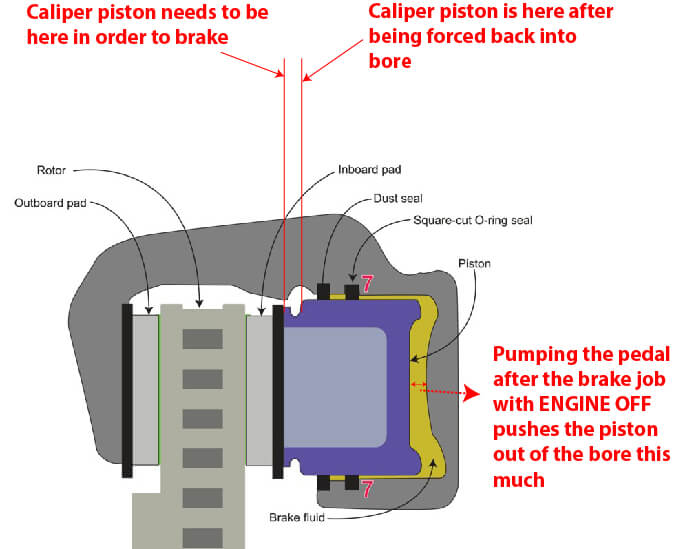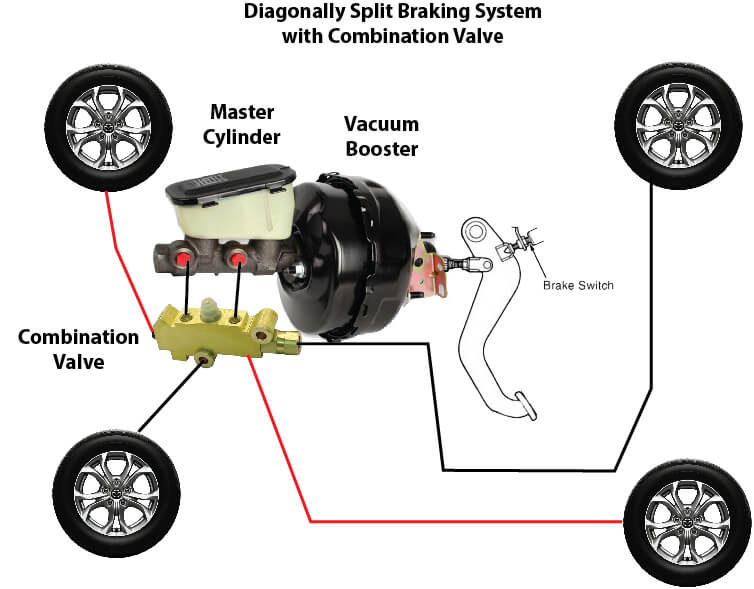Brake light on after brake job
Why is the brake light on after a brake job?
You did your own brake job, and now you’ve got a brake light on after the brake job. Ok, here’s what you did wrong:
The last step in any disc brake job is to return the caliper pistons to a position where they’re contacting the brake pad backing plate. To do that, you compress the brake pedal 2-3 times with the ENGINE OFF until you get a firm pedal. Skip that part, and you’ll have lousy braking and a brake light on.
Why do you have to move the brake caliper pistons out?
When you compressed the piston into the caliper bore, you pressed it in all the way. If you leave it in that position, it won’t contact the pad backing plate when you apply the brakes the first time. In fact, it usually takes 2-3 full pedal pumps to move the piston out far enough to contact the backing plate so it can apply braking pressure.

What causes the brake light to come on?
Most cars and trucks are designed as a diagonally split system. So, the master cylinder is split into two circuits: one for the front left and right rear brakes and a second circuit for the front right and left rear brakes. This design is for safety reasons, to provide braking in the event one circuit fails.
However, car and truck makers also have to factor in the different pressures needed for front versus rear braking and the differences in pressures for disc versus drum brakes. In some vehicles, carmakers may install up to three valves/switches or one “combination switch.”

Metering valve: Allows brake fluid flow to rear drum brakes before providing pressure to the disc brakes. This is done because the shoes in a drum brake system must travel farther and require more fluid movement to activate than is required in a disc brake. Having the rear brakes apply first provides stability during braking and helps keep the car traveling in a straight line.
Proportioning valve: As you brake, the front end of the vehicle tends to dip, while the rear tends to lift up. The amount of body weight shift and rear body lift is directly proportional to vehicle weight and load. The proportioning valve applies more pressure to the rear brakes to counteract body lift. The valve is often attached mechanically to the vehicle body by a rod. As the rear body lifts, the rod moves a piston in the proportioning valve to apply more pressure and reduce the lift.
Pressure differential switch: The differential switch is designed to prevent large fluid loss in case of a line leak or break. If one part of the fluid circuit breaks, a tapered pin is forced off-center to close off the leaking circuit. At the same time, the tapered pin completes an electrical circuit to light the BRAKE warning light on your dash. This alerts you to a potentially serious brake fluid issue.
If you perform a brake job and don’t properly move the caliper pistons so they’re contacting the pad backing plate, you can force the tapered pin off center, turning on the BRAKE light.
Prevent brake light on after brake job
Once the new pads, shims, and brake hardware are installed and torqued to spec, apply firm pressure to the brake pedal with the ENGINE OFF. THE PEDAL WILL GO TO THE FLOOR! Don’t be surprised! Release the pedal and re-apply several times until you get a firm pedal. Make sure you have a firm pedal BEFORE you start the engine.
Reset the pressure differential switch
If you skipped the pedal apply step and now have a brake light on after the brake job, simply shut off the engine and perform it now. If the pedal firms up but the brake light stays on, you’ll have to reset the pressure differential switch. The switch is located in different places on every vehicle. So search for “reset pressure differential switch” to find the location and procedure for your vehicle.
©, 2018 Rick Muscoplat
Posted on by Rick Muscoplat
